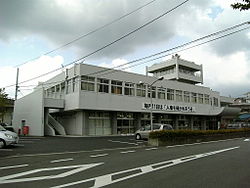| Sangō 三郷町 | |
|---|---|
| Town | |
 Sango Town Office Sango Town Office | |
 Flag Flag Seal Seal | |
| Location of Sangō in Nara Prefecture | |
 | |
 | |
| Coordinates: 34°36′01″N 135°41′44″E / 34.60028°N 135.69556°E / 34.60028; 135.69556 | |
| Country | Japan |
| Region | Kansai |
| Prefecture | Nara |
| District | Ikoma |
| Area | |
| • Total | 8.79 km (3.39 sq mi) |
| Population | |
| • Total | 22,529 |
| • Density | 2,600/km (6,600/sq mi) |
| Time zone | UTC+09:00 (JST) |
| City hall address | 1-1-1 Seyanishi, Sangō-chō, Ikoma-gun, Nara-ken 636-8535 |
| Website | Official website |
| Symbols | |
| Flower | Sunflower |
| Tree | Maple |

Sangō (三郷町, Sangō-chō) is a town located in Ikoma District, Nara Prefecture, Japan. As of 1 April 2024, the town had an estimated population of 22,529 in 10,673 households, and a population density of 2600 persons per km. The total area of the town is 8.79 km (3.39 sq mi)
Geography
Sangō is located in western Nara Prefecture, sitting right next to the border with Osaka Prefecture, the Yamato River flows through. The majority of the land is flat, as like other municipalities in the Nara Basin. However, the Ikoma Mountain Range situated in the western portion of the town, on the border between Osaka Prefecture.
Neighboring municipalities
Climate
Sangō has a humid subtropical climate (Köppen Cfa) characterized by warm summers and cool winters with light to no snowfall. The average annual temperature in Sangō is 14.6 °C. The average annual rainfall is 1636 mm with September as the wettest month. The temperatures are highest on average in August, at around 26.7 °C, and lowest in January, at around 3.1 °C.
Demographics
Per Japanese census data, the population of Sangō is as shown below:
| Year | Pop. | ±% |
|---|---|---|
| 1940 | 5,273 | — |
| 1950 | 6,538 | +24.0% |
| 1960 | 6,723 | +2.8% |
| 1970 | 10,023 | +49.1% |
| 1980 | 17,949 | +79.1% |
| 1990 | 23,123 | +28.8% |
| 2000 | 23,977 | +3.7% |
| 2010 | 23,440 | −2.2% |
| 2020 | 23,219 | −0.9% |
History
The area of Sangō is part of ancient Yamato Province. The village of Sangō was established on April 1, 1889 with the creation of the modern municipalities system. It was raised to town status on April 1, 1966.
Government
Sangō has a mayor-council form of government with a directly elected mayor and a unicameral town council of 13 members. Sangō, collectively with the other municipalities of Ikaruga District contributes two members to the Nara Prefectural Assembly. In terms of national politics, the town is part of the Nara 2nd district of the lower house of the Diet of Japan.
Economy
Sangō has a mixed economy of agriculture and light manufacturing. Due to its location, the town is increasing becoming a commuter town for the greater Osaka metropolis.
Education
Sangō has two public elementary schools and one public junior high school operated by the town government and one public high school operated by the Nara Prefectural Board of Education.
Transportation
Railways
[REDACTED] JR West - Kansai Main Line (Yamatoji Line)
Highways
Local attractions
References
- "Sangō town official statistics" (in Japanese). Japan.
- 考える社会科地図 Kangaeru Shakaika Chizu. 四谷大塚出版 Yotsuya-Ōtsuka Shuppan. 2005. p. 36.
- Sangō climate: Average Temperature, weather by month
External links
- [REDACTED] Media related to Sangō, Nara at Wikimedia Commons
- Sangō official website (in Japanese)
| Nara (capital) | ||
| Core city | ||
| Cities | ||
| Districts | ||
| List of mergers in Nara Prefecture | ||
This Nara Prefecture location article is a stub. You can help Misplaced Pages by expanding it. |